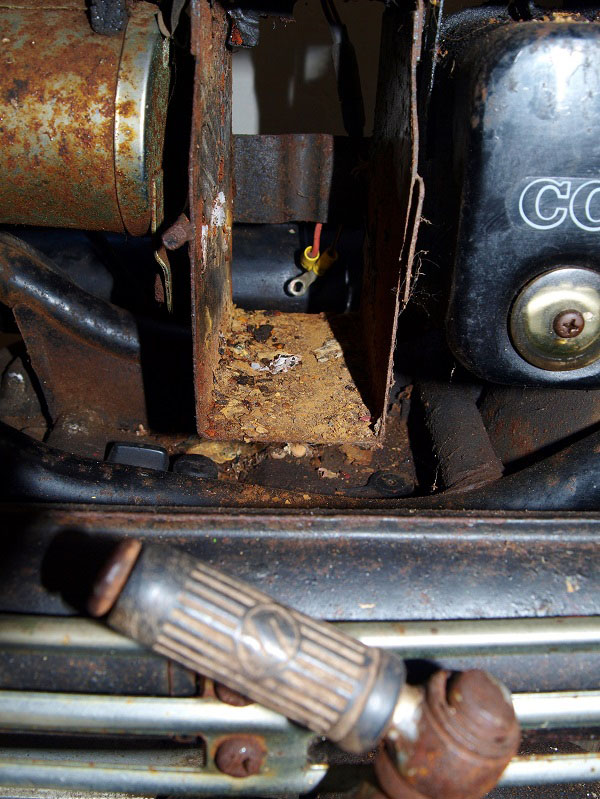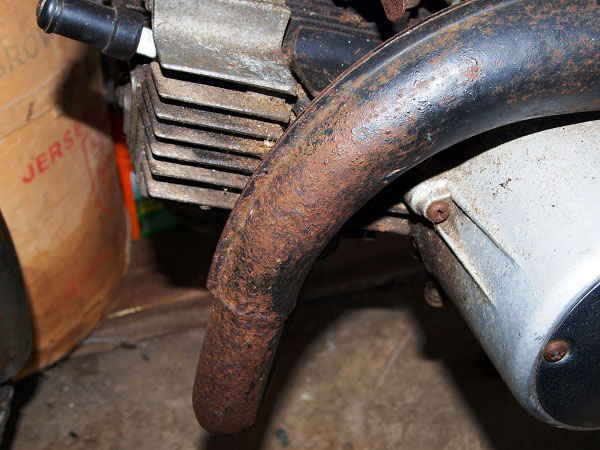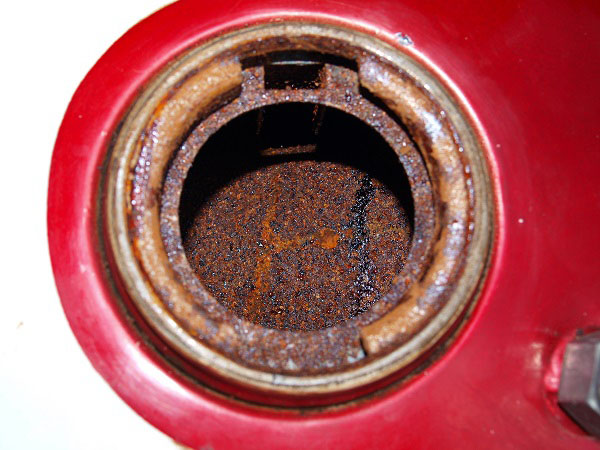Workshop Guide to Corrosion Prevention
by Steve Cooper, VJMC Editor
Having finally restored a bike or bought the machine of your dreams, you fettle it, ride it, check it over, wheel it in and out of the garage/shed and generally enjoy the whole experience. At some point, you are likely to have to lay the bike up or leave it unused for a protracted period.
Unless circumstances beyond your control overtake events, it’s normally possible to give some considered thought to the conditions and surroundings a bike is kept in. The environment in which a vehicle is stored has a very real impact on its long-term well being and cosmetic appearance. With a bit of forethought and planning, and armed with a few basic facts, most of us should be able to minimise a bike’s corrosion potential.
Cleaning and polishing a bike’s alloy, chrome or paintwork is very laudable but doesn’t necessarily preserve the appearance for very long. Getting to grips with the basics of corrosion can greatly assist in understanding what needs to be done to preserve a bike’s appearance and value. Metals are generally happiest when they can revert back to their parent ore or something similar.
It’s a process we enthusiasts are only all too familiar with. Steel and iron rusts, aluminium alloys try to grow fur coverings and chrome turns a lovely shade of green/blue. Each and every corrosion process is advanced by the presence of three pivotal substances; oxygen, water, and metal salts.
By removing one (or preferably two) from the equation, corrosion is either overcome or very substantially reduced. Our guest Suzuki, pictured below, has spent far too long in a damp barn or similar and has suffered accordingly. Its new home is a rather basic brick garage that’s prone to damp and condensation and this hasn’t done it any favours either.

An obvious, if expensive, route is to keep your bikes in a heated environment. A heated garage is potentially bike storage nirvana but it’s a luxury very few of us can afford and only a select band are able (or allowed) to keep bikes in the house. Unfortunately, this can also be something of a double-edged sword. The laws of chemistry state that a reaction is almost inevitably accelerated in the presence of heat and unless the bike is clean and free from metal salts and moisture and/or condensation the inevitable decay and corrosion processes will happen.
To avoid the sort of mess we have here, the residues left behind by a poorly vented battery should have been removed and neutralised. The acidic vapours from the battery have simply accelerated the corrosion process and if left unchecked will eventually eat their way through another irreplaceable motorcycle component. Battery acid and its resultant fumes are highly corrosive and something as innocuous as a blocked breather pipe can wreak costly damage not only on painted steel but also on expensive chrome plating - so ignore batteries and breather pipes at your peril.
A heated facility is fine but unless the garage is dry and the bike is free from salts of any kind, heating is only going to make things worse. Realistically the best way to stave off the ingress of moisture is to invest in a dehumidifier. These machines are able to remove the airborne moisture that kicks off and subsequently perpetuates corrosion and once your garage is at a reasonably low level of humidity the power consumption is actually minimal.
Dehumidifiers were once expensive luxuries but with the advent of the internet, it’s perfectly possible to buy a unit suitable for a garage from around £35-40. When this is offset against the price of re-chroming a mudguard at £70 or more it has to be seen as something of an investment. If the moisture level is sufficiently low it is impossible for the water to condense on your bikes - job done.
If a garage or workshop physically leaks, then you know you are onto a hiding to nothing. If the floor sweats moisture consider a couple of coats of good quality garage floor paint to reduce the worst of the effects. If the walls are prone to damp they can be sprayed on the outside with a sealer; doing this is actually quite quick and disproportionately very effective.
Single glazed windows can be a real source of moisture due to condensation but with a bit of ingenuity and cheek, most can be replaced at low cost. Have a word with your local double glazing firm. You’ll be amazed at just how cheaply you can buy double glazed units they’ve made to the wrong dimensions. We old motorcycle enthusiasts are an ingenious bunch as a rule and with a bit of savvy, an apparently scrap double glazed window can be made to fit most garages or sheds.
The time-honoured method of covering a bike in grease, oil, Vaseline etc is still perfectly viable but it’s also horribly messy. It works on the principle that you are excluding atmospheric moisture and oxygen from the bike’s corrodible surfaces. Fortunately, science has moved on since the 1920s and there are a number of proprietary products that will protect a vehicle either in storage or one in regular use.
A trip to your local dealer should see you sorted with protectants and corrosion pacifiers. Products like ACF-50 are a real boon to the average restorer. This material not only protects but also chemically lifts corrosion from the metal’s surface. Four year’s storage in an unheated but dehumidified garage as a long-term project hasn’t done the inside of this original and genuine NOS Yamaha mudguard any harm; modern protective chemicals really are the business.
Several companies market giant plastic bags that you wheel your bike(s) into. Dependant on the type you either evacuate out all the air or inflate with a small compressor. Either type normally relies on using a moisture-adsorbing desiccant that is regularly regenerated in a domestic oven. If you have the space for the latter these are pretty much ideal. However, when not in use the bag needs to be stored safely to prevent damage/ripping or they won’t function effectively. Cheapskates, please take note, an old blanket thrown over your bike does not have the same protective effects.
None of the above will be of use unless your bike is clean. If there are salts of any type on the vehicle corrosion is likely to be a very real threat. Most salts will pick up moisture thereby setting up an electrolytic cell and provide sufficient power over a storage period to cause real damage. It’s not just road salt that can accelerate corrosion. The nasty muck around battery terminals can cause real issues as can bird poo, dead insects, the sticky secretion from trees, the calling card of next door’s tomcat or even a sweat-laden hand placed on the clean alloy. Before a bike is stored or laid it should be clean and dry. It’s a shame no one told the Stinger’s owner. Those exhaust pipes look like they could be a lost cause.

There are lots of old wives tails about what to do with an engine that’s not being used, but one thing is guaranteed to be a 100% killer. Firing up a bike once a month for a few minutes just to make sure everything is lubricated is probably not a good idea. This process is really bad news in terms of corrosion; the combustion process evolves water and acidic components and unless the engine and its oil are taken to full operating conditions for a protracted period the acids and water will happily corrode bearings, cases, bores and rings.
In this instance, doing nothing is better than doing something half-heartedly. Ideally on a four-stroke, drop out the old oil while the engine is hot, fill with new oil and turn the motor over with the plugs out and the fuel and ignition off. This way everything gets a coating of fresh clean oil. If you want to turn the engine over during a layup, fine, but don’t fire it up unless you are going to be riding it or getting it properly warmed up.
A viable belt and braces approach can be to add a few millilitres of Redex or similar down the bores to prevent rings from becoming stuck in piston lands. This column has experience of an XS650 that had sat for 20+ years and the rings had become partially stuck in the piston lands. A four-week steeping in Redex freed the rings, reduced the oil consumption to zero and negated an expensive strip down. Unfortunately, this really isn’t viable on a two-stroke.
If you think your treasured stink wheels might be standing for a long time and the crank seals may dry out when you finally stop running the bike, turn off the fuel and pull the oil pump cable so the pump is running at maximum. This will ensure the bottom end and seals are well lubed until next year. If you run premix you may just have to run a really oily half a litre to get the same effect. The worse you are likely to see when you come to start the bike is a fouled plug.
Exhausts can be a real worry as mentioned; four-stroke systems normal die due to internal corrosion. Two-strokes seem to be immune from this problem due to the oily nature of their combustion process but they can rust from the outside in (like our Stinger here). Back in the late 70s one of the motorcycle magazines ran an article on preserving four stroke exhausts. The journalist recommended swilling the insides with low viscosity silicone fluid or if that wasn’t available two-stroke oil. Given the obvious precautions of oil on tyres and a bit of extra smoke, this seems to be a very attractive solution to an age-old problem. Looking at the price of a complete Z1 exhaust system these days it sounds like a real bargain.
Ceramic coatings are now significantly more viable than they once were and several firms are offering such services. Having the inside of an expensive and rare system coated with ceramic may be relatively expensive but if it stops those dreaded rust bubbles appearing through the chrome a few years after a full-on restoration it may well be a worthwhile investment. Another dodge that can work well in terms of protecting an engine and exhaust is to block off any opportunity for moisture ingress; this is well worth considering if you know the storage area will inevitably be damp.
Polythene bags can be stuffed in the exhausts and inlet tracts, taped in place or secured with rubber bands and bungee straps. Do this when the engine is cold and the humidity low and the entire motor will be essentially free from moisture and thus corrosion. If no air can move through the inlet and exhaust the entire motive unit can sit in its own microclimate nicely snug until spring.
Fuel tanks can and are regularly overlooked; if the outside looks OK and is still nice and shiny we tend to ignore them. Unfortunately, corrosion goes on at a fair old pace and before you know it you’re looking at pinholes, petrol stains to the paint and worse. As air enters the tank via the breather hole it’s in contact with the surface of the sloshing petrol and quickly deposits its moisture. Modern unleaded fuel contains oxygenated solvents to assist in the combustion process and these chemicals have a somewhat morbid obsession with water. They will absorb quite high moisture contents and this is obviously bad news for us.
Eventually, the water level in the fuel will reach a point where it will promote internal corrosion and the results are inevitable. If you are not riding a bike for a long period it really is worth draining the petrol out and giving the tank’s internal surfaces a quick blast with a spray-on light oil to minimise corrosion. Adding a thin layer of plastic sheet under the cap will successfully stop any damp air entering the tank during the layup. There are various forms of tank liner available and most will do a reasonable job if you have a leaking tank but they have their limits; they should not be applied over existing rust. For the same reason that none of us would apply a fibreglass patch to the rusty sill of a car, the tank liner cannot be expected to actually halt corrosion.

There’s one last, but very often forgotten and overlooked point. Ultraviolet light (UV) attacks/oxidises plastics and paintwork, it also degrades rubber. A bike “preserved” in a conservatory will still suffer from environmental decay. You only have to look at the state of acrylic tank badges that have been exposed to the sun to get an idea of the damage UV can perpetuate.
If you aren’t looking at the bike it doesn’t need daylight. Ultraviolet degradation perpetuates an insidious form of decay and it’s a type that is generally untreatable. At worst a faded tank can be repainted but once the clear plastic “glasses” of a Suzuki GT250’s clocks are yellow and crazed or the badges on your tank have curled up at the edges replacement is the only option.
So to sum up; prevent the ingress of oxygen, water, metal salts + UV and you’ll still be smiling benignly well into your dotage. It’s impossible to totally prevent the corrosion process, but with a bit of common sense and a small amount of investment, it can be majorly reduced. It’s just a shame there’s nothing that stops us lot degrading with age.
For more technical advice, visit Motorcycle Workshop Guides: The Complete List.
To find out more about a classic bike policy from Footman James and to get to an instant quote online, visit our Classic Bike Insurance page.
The information contained in this blog post is based on sources that we believe are reliable and should be understood as general information only. It is not intended to be taken as advice with respect to any specific or individual situation and cannot be relied upon as such.

COMMENT